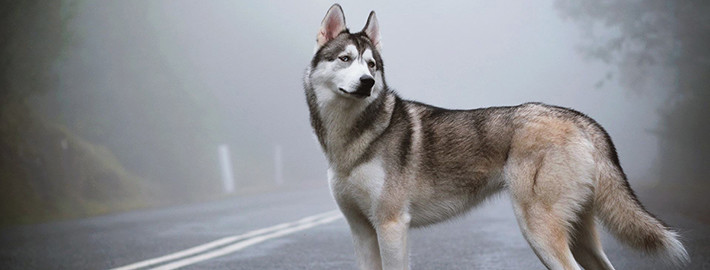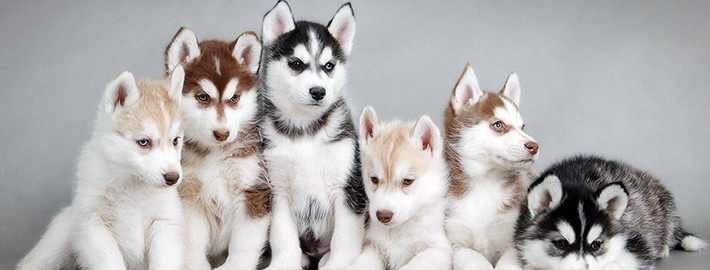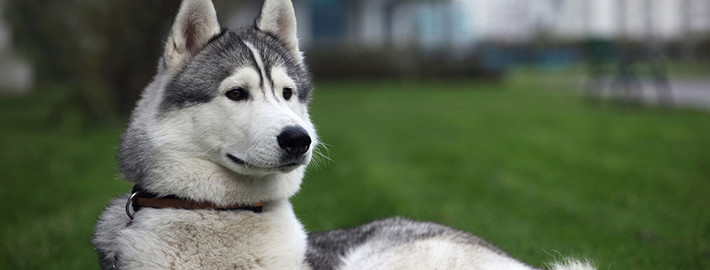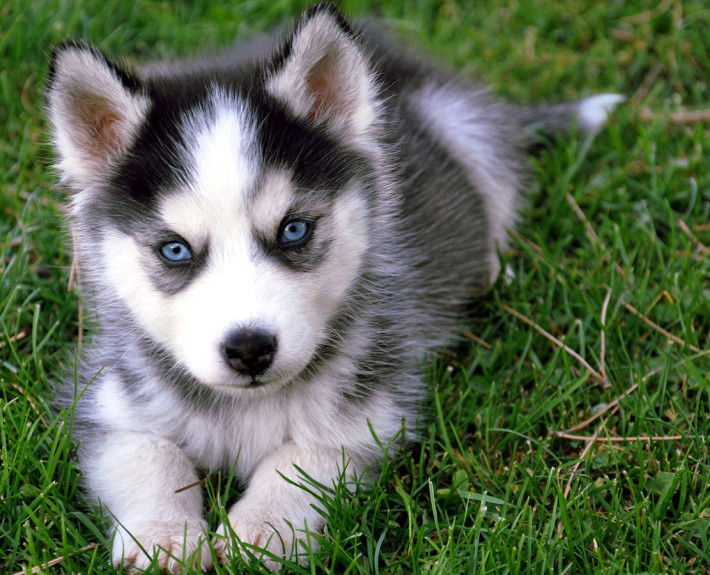What makes the Siberian Husky Unique?
The Siberian husky combines power, speed and endurance, enabling it to carry a light load at moderate speed over a great distance. It is moderately compact, slightly longer than it is tall, and of definite Northern heritage. It is quick and light on its feet, with a smooth and effortless stride exhibiting both good reach and drive. It has a double coat of medium length, with a soft, dense undercoat and a straight, somewhat flat-lying outer coat. Its expression is keen but friendly, interested and even mischievous. Fun-loving, adventurous, alert, independent, clever, stubborn, mischievous and obstinate — all describe the Siberian husky. This breed loves to run and will roam if given the chance. It may be aggressive toward strange dogs, but it is generally good with other household dogs. In fact, it is a very social dog that must have human or canine companionship. It may chase strange cats or livestock. Some howl, dig and chew.
Breed Groups
- Working Dog Breeds
- Large Size
Page Contents
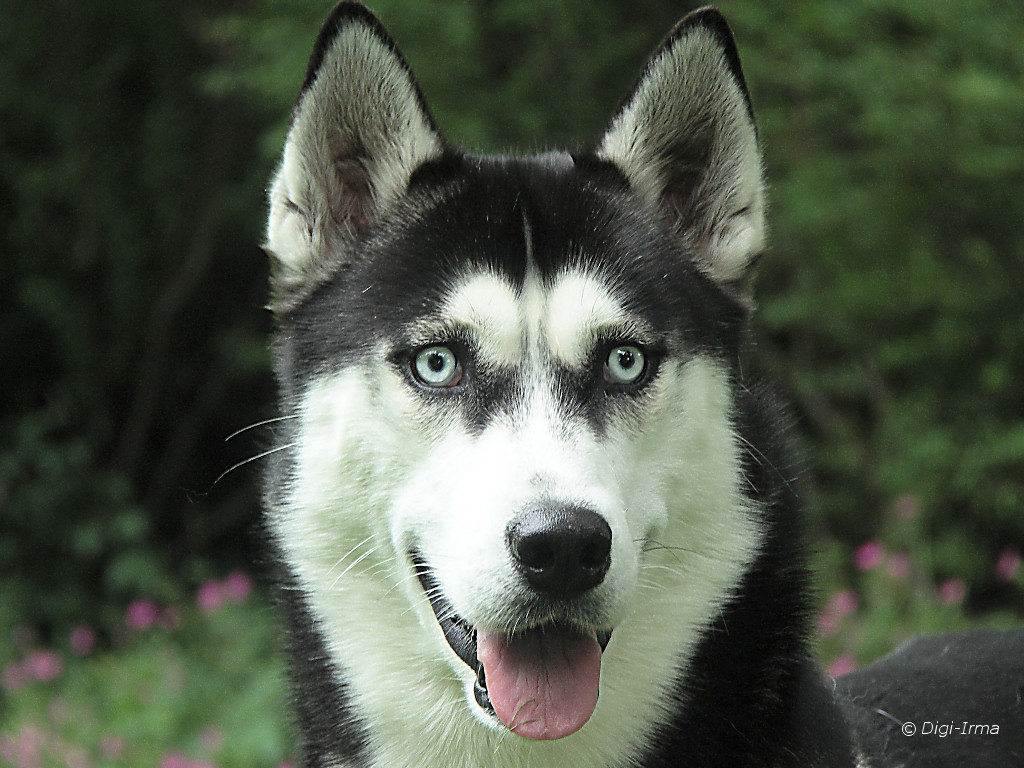
SnapShot
| Size: | Males – 21 and 23.5 inches (53 and 60 cm) Females – 20 to 22 inches (51 to 56 cm) |
| Weight: | Males – 45 and 60 pounds (20 and 27 kg) Females – 35 to 50 pounds (16 to 23 kg) |
| Origin: | Russia |
| Life Span: | 12 to 14 years |
| Colour: | Black, White, Red, Brown, Gray, Silver, Wolf-gray, Sable, Red-orange, Dark-gray, Piebald |
| Litter Size: | 6-8 puppies |
Is the Siberian Husky Right For You?
Siberians are relatively easy keepers, but their thick coats require weekly brushing. New owners should be prepared to provide an outlet for exercise daily, whether through walks or an enclosed space in which to run. Predatory instincts are strong, so Siberians should be supervised around small animals in and around the home. If you are considering purchasing a Siberian Husky puppy, learn more. *Working Group; AKC recognized in 1930.
*Ranging in size from 20 to 23 ½ inches tall at the shoulder and 35 to 60 pounds.
*Sled dog.
In 5 Words
- Alert
- Outgoing
- Friendly
- Gentle
- Intelligent
Characteristics
Learn About the Siberian Husky
Description
Siberian Huskies are strong, compact, working sled dogs. The medium-sized head is in proportion to the body, with a muzzle that is equal in length to the skull, with a well-defined stop. The color of the nose depends upon the color of the dog’s coat. It is black in gray, tan or black dogs, liver in copper dogs and flesh-colored in pure white dogs. The medium-sized, oval-shaped eyes are moderately spaced and come in blue, brown, amber or any combination thereof. Eyes can be half blue and half brown (parti-eyed), or dogs can have one blue eye and one brown eye (bi-eyed). The erect ears are triangular in shape, and set high up on the head. The teeth meet in a scissors bite. The tail is carried over the back in a sickle curve, not curved to either side when the dog is excited. The large “snow shoe” feet have hair between the toes to help keep them warm and for gripping on ice. Dewclaws are sometimes removed. The medium-length, double coat is thick and can withstand temperatures as low as -58° to -76° F (-50° to -60° C). The coat also comes in a longhaired variety called a wooly coat. The wooly (sometimes spelled woolly or wooley) coat length comes from a resessive gene and is not in most of the kennel club’s written standard. Coat colors include all, from black to pure white, with or without markings on the head. The face mask and underbody are usually white, and the remaining coat any color. Examples of common colors are black and white, red and white, brown, gray and white, silver, wolf-gray, sable and white, red-orange with black tips, dark gray and white. Piebald is a very common coat pattern.
Short History of the Siberian
The Chukchis, a semi-nomadic people of northeastern Asia, are responsible for developing the Siberian Husky. And though the breed’s lineage remains a mystery, the Husky is probably of spitz stock, taking several centuries for the Chukchis to train them as sledge dogs. Famously used during the Alaskan gold rush, the Siberian Husky was an essential laborer in the Arctic regions, later emerging as the primary breed used in dog racing, a popular form of entertainment in these regions.
One such racing event, the 400-mile All Alaska Sweepstakes Race from Nome to Candle, traversed some of Alaska’s most arduous areas. During the second annual All Alaska’s Sweepstakes Race in 1909, the first team of Siberian Chukchi huskies were entered. Because of their docile nature and small size, the dogs were hardly acknowledged as worthy competitors.
However, a young Scotsman named Charles Fox Maule Ramsay took notice of the breed and had his team’s lead rider, John “Iron Man” Johnson, use them to pull his sled in the 1910 All Alaska Sweepstakes race, defeating his competitors handily (Johnson and his huskies still hold the race’s fastest finish time, 74:14:37). Ramsay’s other teams, which were also led by Siberian Huskies, assumed the second and forth positions in the race, further evidence of the breed’s dominance in the sport. For the next decade, the Siberian Husky was used to capture some of the most prestigious racing titles in Alaska, especially where the rugged terrain was suited to the breed’s endurance capability.
In 1925, the city of Nome, Alaska was stricken by a diphtheria epidemic and supplies of its antitioxin were urgently needed. In what came to be known as the “Great Race of Mercy,” 20 mushers (human riders) and 150 sled dogs transported the diphtheria antitioxin 674 miles across Alaska in a record-breaking five and a half days, thus saving the city of Nome and its surrounding communities. Instantly, the mushers and their dogs became famous across the United States for their bravery and heroics. Balto, the lead sled dog on the final stretch into Nome and a Siberian Husky, would particularly gain publicity for the serum run and a statue was erected in New York City’s Central Park just 10 months after Balto’s arrival in Nome.
The Siberian Husky’s popularity soon spread into Canada and in 1930, the American Kennel Club officially recognized the breed. Several Siberian Huskies would later serve in the U.S. Army’s Arctic Search and Rescue Unit during World War II. The breed continues to astonish racing fanciers with its speed and endurance, but has also become quite a popular show dog and family pet.
Temperament
The temperament of a Siberian Husky is cautious and alert – you have to be worthy of their attantion. They are not overly suspicious of strangers or aggressive with other dogs.
He is a quick and athletic dog with a moderately compact build and a smooth, effortless gait. This intelligent breed is friendly and gentle and usually bonds more deeply with one person in the family. The Siberian is an independent thinker and can be a bit stubborn at a time. Still, if properly trained then he makes a great companion for the whole family and has a natural affinity for children. Some measure of reserve and dignity may be expected in the mature dog. His intelligence, tractability, and eager disposition make him an agreeable companion and willing worker. The Siberian Husky is not a protective nor possisive dog, it will often share it’s treasures and treats with friends.
Although he is oftan affectionate to his entire family, the Siberian is really a one-man dog. With the fact that he is not naturaly suspicious towards strangers, this breed does not make a very good watch dog. The free spirit of the Siberian Husky gives him a very real wolf like feel he digs, he hunts and he must run! He is by nature meticulously clean and can often remind of a cats temperament.
One very positive trait of the husky is that it is a quiet dog, he seldom barks. Still many are very talkative and will howl with soft “boo” to tell you that he is happy to see you or is glad for other reasons. He will often show his affection towards the ones that have earned it, lay his head in your lap or give a kiss when he walks by. The Siberian Husky is a greatfull and thankfull breed.
Caring for Your Siberian Husky
Grooming & Bathing
Huskies are heavy shedders – they lose hair year round. Shedding is especially heavy twice per year as they seasonally blow their coats. Dogs in cooler climates typically shed less than dogs who live in warm areas. Brushing the Husky once per week at a minimum can help keep shedding under control and prevent mats from forming, though daily brushing is required during shedding season.
Siberian Huskies are odor free, naturally clean animals who, like cats do, will clean themselves on a regular basis. This means that it’s only necessary to bathe a Siberian Husky as needed.
Check the ears on a weekly basis for signs of infection, irritation, or wax build up. Cleanse regularly with a veterinarian-approved cleanser and cotton ball. Brush the teeth at least once per week to prevent tartar buildup and fight gum disease. Additionally, nails should be trimmed once per month if the dog does not wear the toenails down naturally.
Exercise & Training
Siberian Huskies need a fair amount of exercise, including a daily walk or jog, but should not be excessively exercised in warm weather. They need a large yard with a high fence, but bury the wire at the base of the fence because they are likely to dig their way out and go off hunting.

